Need some inspiration for your next email marketing campaign? In this quick guide, we’ll share 5 battle-tested email sequence examples that you can use to generate more opens, clicks, and conversions.
When it comes to email marketing, sending the right message at the right time can make all the difference. And that’s precisely what makes email sequences so powerful. In fact, research shows that email sequences generate 320% more revenue than one-off emails.
Whether you’re nurturing new leads, welcoming subscribers, or re-engaging inactive customers, a well-crafted email sequence can help you boost engagement, build trust, and drive more conversions.
But here’s the thing. Many marketers struggle to create effective email sequences. They often rely on generic templates, or send sporadic campaigns that don’t yield the desired results.
So in this article, we’ll share 5 essential email sequence examples that every marketer should have in their toolkit. These series will help you connect with your audience at every stage of the customer journey.
Here’s what we’ll cover:
- What is an email sequence?
- 5 high-ROI email sequence examples
- How to create an email sequence?
- How long should your email sequence be?
- Automate your lead generation with email sequences
Sounds good? Then let’s dive in.
What is an email sequence?
An email sequence is a series of emails that you can send to your subscribers or customers using automation tools such as Mailmeteor. These emails are sent automatically based on specific triggers or a predetermined schedule.
You can strategically plan your email sequence to deliver nuggets of information, one piece at a time, and guide recipients through a journey, whether it’s onboarding new customers, nurturing leads, or re-engaging inactive subscribers.
Email sequences are often tailored to the recipient’s behavior, or the stage they’re in within the customer journey. For example, when someone downloads an ebook, they might receive a welcome email sequence.
These emails could start with a thank-you message, followed by a series of educational emails designed to build trust, provide value, and encourage further engagement with your brand.
The power of an email sequence lies in its ability to deliver the right message at the right time, allowing you to maintain consistent communication with your audience, increase engagement rates, and drive more conversions.
5 high-ROI email sequence examples
Creating an email sequence from scratch can be challenging, especially if you’re not an experienced marketer.
The process involves careful planning, strategic thinking, and a deep understanding of your audience. But don’t worry—we’re here to help!
To make it easier for you, we’ve compiled 5 proven email sequence examples that you can use for inspiration and adapt to your needs.
1. Onboarding sequence
An onboarding sequence helps you welcome new subscribers or customers and sets the tone for your future relationship. This series aims to familiarize newcomers with your brand while providing immediate value.
Structure of the sequence:
- Day 1: Welcome and thank you
- Day 3: Introduce key features or benefits
- Day 5: Share a helpful resource or tip
- Day 7: Present social proof
- Day 10: Offer a special “new subscriber” promotion
Example from OnlyDomains:

Source: reallygoodemails.com
2. Cold email outreach sequence
A cold email sequence is designed to initiate contact with potential clients or partners who haven’t interacted with your brand. The goal is to introduce your company, provide value, and ultimately secure a meeting or a call.
Structure of the sequence:
- Day 1: Introduction and value proposition
- Day 3: Share relevant content or case study
- Day 5: Address common pain points
- Day 7: Offer a low-commitment call to action
- Day 10: Final follow-up
Example from Mailmeteor:
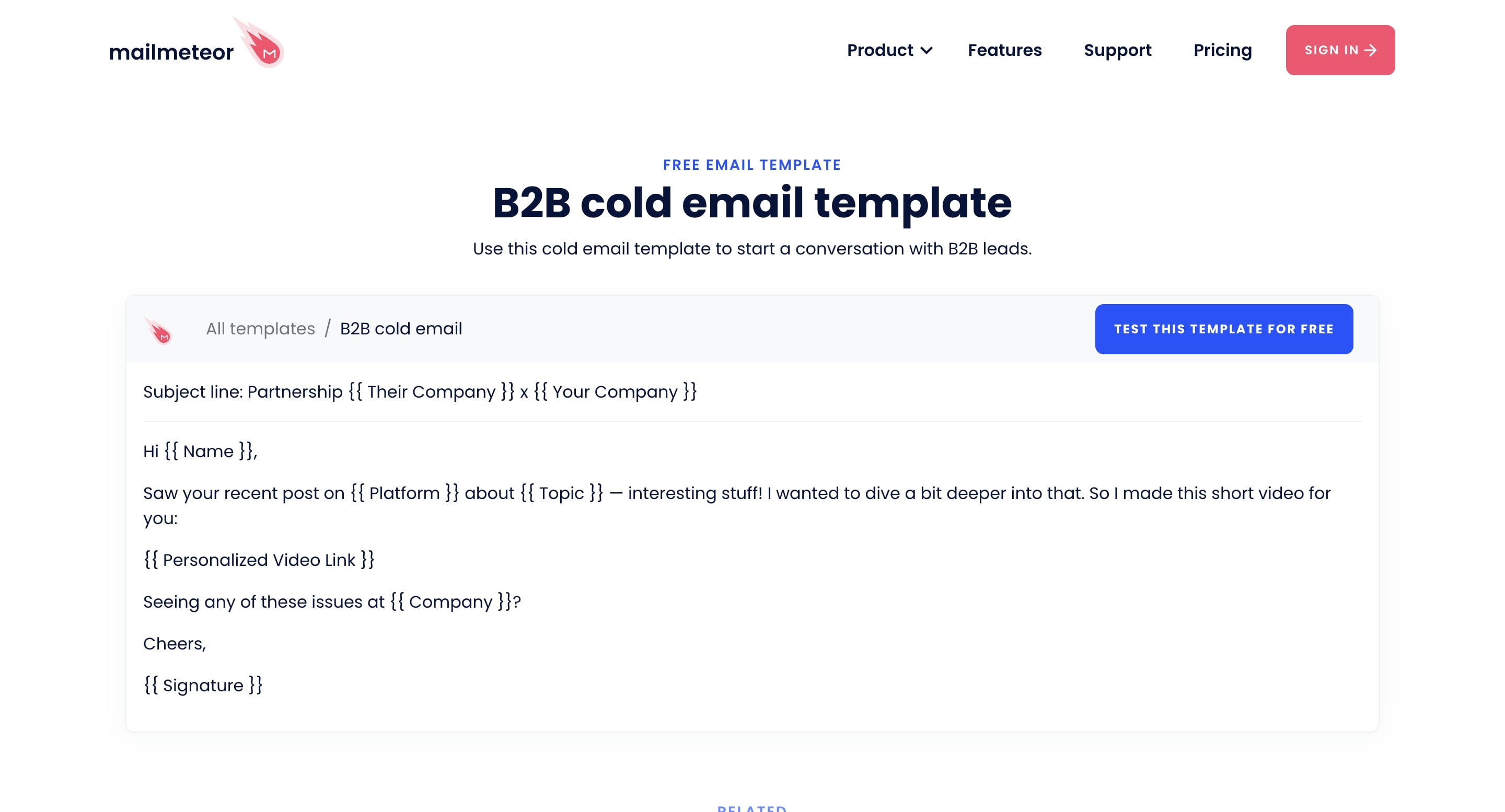
Source: reallygoodemails.com
3. Abandoned cart sequence
An abandoned cart email sequence targets potential customers who have added items to their shopping cart but left without completing their purchase. The sequence encourages these customers to finalize their order.
Structure of the sequence:
- After 1 hour: Gentle reminder
- After 24 hours: Address potential concerns
- After 48 hours: Offer an incentive
- After 72 hours: Create urgency
- After 5 days: Final reminder
Example from Rael:

Source: reallygoodemails.com
4. Automated webinar sequence
A webinar email sequence helps you promote and follow-up on evergreen webinar content, maximizing engagement and conversions. This sequence guides potential attendees from registration through post-webinar actions.
Structure of the sequence:
- Upon registration: Confirmation and thank you
- 24 hours before: Reminder and build excitement
- 1 hour before: Last-minute reminder
- Immediately after: Thank you and replay link
- 24 hours after: Follow-up with offer
- 3 days after: Final offer reminder
Example from BeeFree:
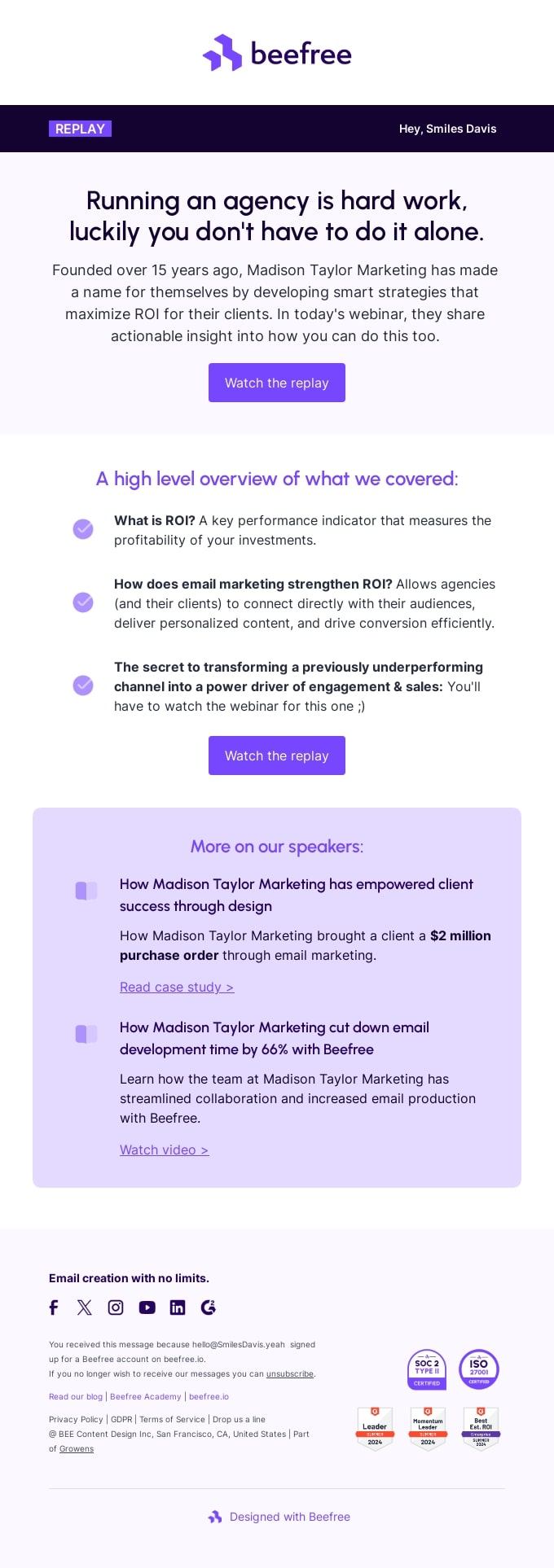
Source: reallygoodemails.com
5. Re-engagement sequence
The goal of a re-engagement email sequence is to win back inactive subscribers or customers who haven’t interacted with your emails in a while. This series is designed to rekindle interest and remind them of the value your brand offers.
Structure of the sequence:
- Day 1: “We miss you” message
- Day 3: Highlight new features or products
- Day 5: Offer exclusive content or discount
- Day 7: “Last chance” offer
Example from YouTube:

Source: reallygoodemails.com
How to create an email sequence?
Creating an automated email sequence has never been easier. With a little from modern emailing platforms, such as Mailmeteor, you can set up drip campaigns or schedule follow-ups in minutes. Here’s how it works.
1. Define your goal
For starters, identify the specific outcome you want to achieve with your email sequence. Are you looking to onboard newcomers ? Nurture leads through a sales funnel? Recover abandoned carts? Launch a new product?
Your goal will shape every aspect of your sequence, from the number of emails to the content within them. Set measurable objectives, such as increasing click-through rates by 20% or boosting conversions by 15%, to track your success.
2. Segment your audience
Your email sequence should focus (almost) exclusively on your recipient. What’s in it for them? Dive deep into your customer data to segment your mailing list based on demographics, behavior, or preferences.
For instance, you might create separate sequences for new subscribers versus inactive users, or long-time customers. The more granular your segmentation is, the more personalized and effective your sequences can be.
3. Map out their journey
With your goal and audience in mind, plan the structure of your sequence. Determine how many emails you’ll send, and the ideal frequency. For an onboarding sequence, you might start with a welcome email, followed by 3-4 emails over two weeks introducing key features.
For each email outline the main message and call-to-action. Make sure to deliver the right information at the right time. You can create a flowchart using tools like Lucidchart (or a spreadsheet) to visualize how recipients will move through your sequence based on their actions.
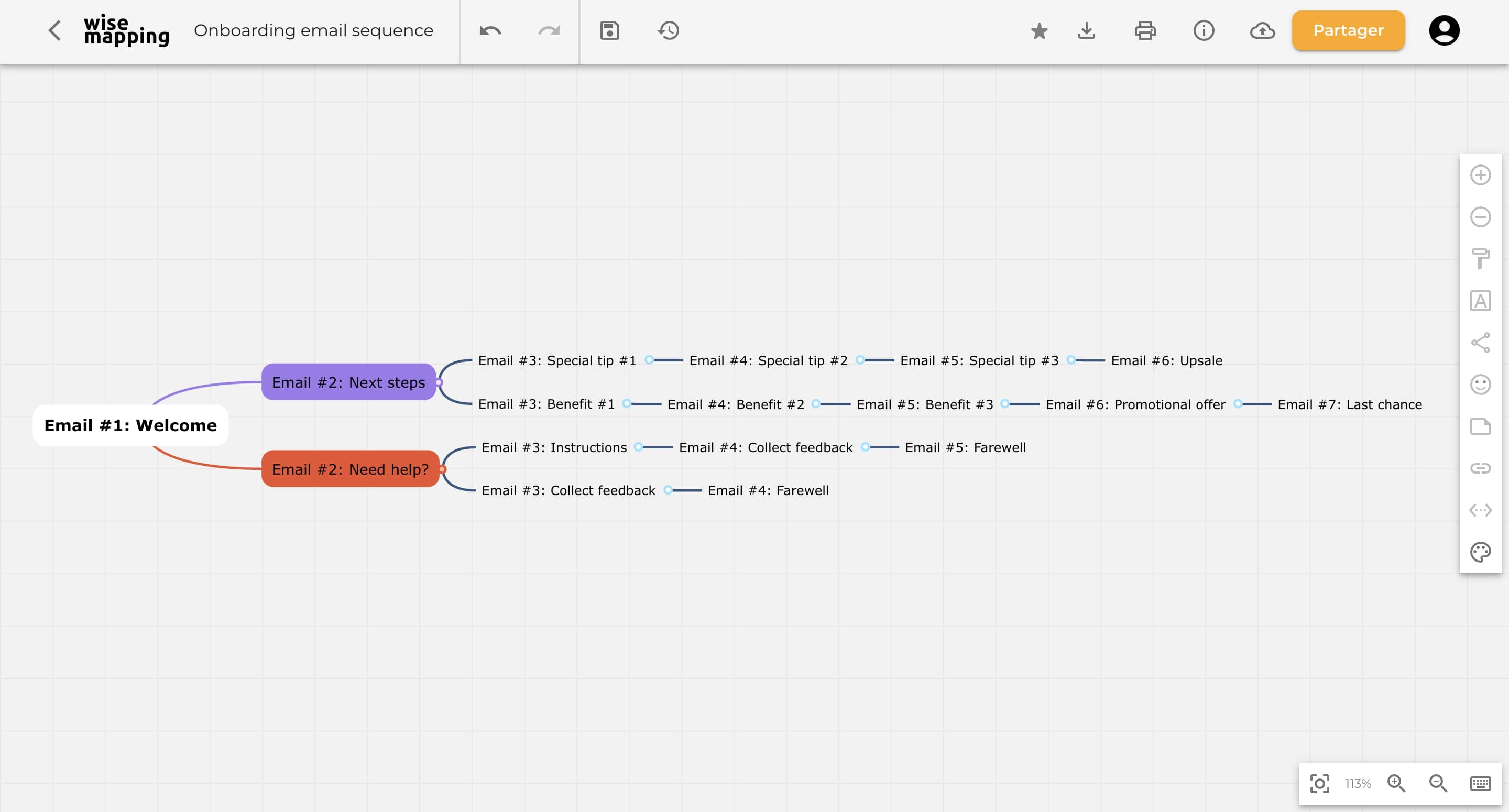
4. Craft your emails
Now it’s time to bring your email sequence to life with engaging content. Start with attention-grabbing subject lines that entice recipients to open your emails.
Need help? Check out this curated list of the best subject lines or use our free subject line generator to get AI-powered recommendations.
For the body content, focus on providing value that aligns with your sequence goal. For example, if you’re nurturing leads, each email might address a common pain point and showcase how your product solves it.
Make sure to include clear, action-oriented CTAs in each email, guiding recipients towards your desired outcome. Also, remember to maintain a consistent brand voice throughout the email series.
5. Automate your sequence
Almost there. Now let’s find an automation tool to set up your email sequence. In this example, we’ll use Mailmeteor, because it is affordable and simple to configure. But there are other tools out there, like Lemlist, Sendinblue, or GMass.
For starters, sign up to Mailmeteor and click New campaign. Then click Select recipients and import your contacts from a CSV file, a Google Sheets, or copy-paste their email addresses.
Personalize the first email of your sequence using variables. This will improve your engagement rates and make your recipients feel special. To add dynamic content to your sequence, click Insert variable and select a variable.
Once your first email is ready, click Add a follow-up email to add more steps to your campaign. Choose when that message will be sent (after 5 minutes, 2 hours, or 3 days), and select a trigger (if no click, if opened, if replied…).
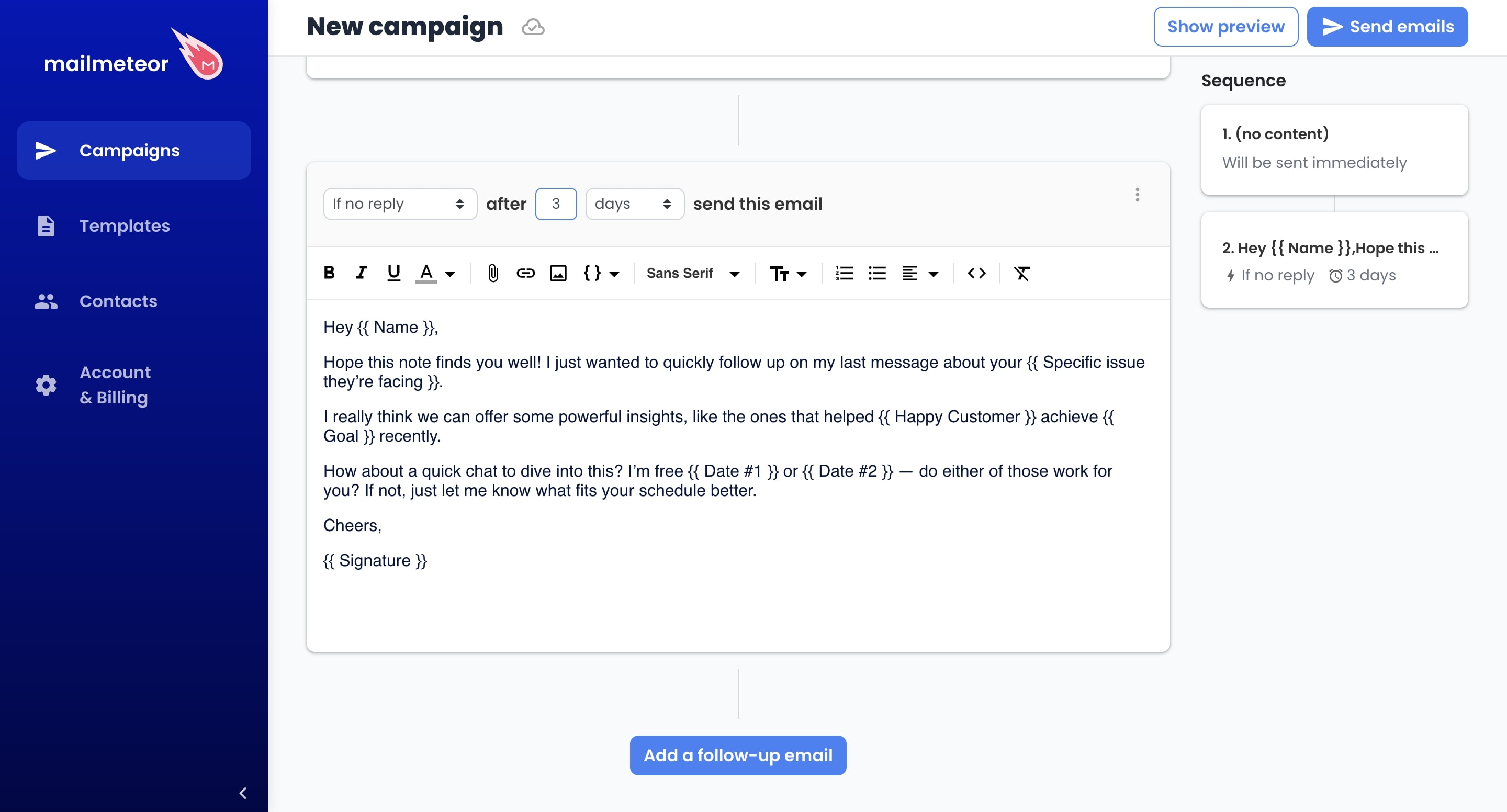
Preview your email sequence and test it before launching to make sure everything works smoothly. Once you’re ready, click Send emails to confirm. And voilà, your email sequence is now up and running, congrats! 🎉
6. Test and optimize
Your work doesn’t end once your sequence is live. Make sure to continuously test and refine your emails to improve performance. Run A/B tests on critical elements like subject lines, email content, CTAs, and sending times.
Monitor key metrics such as open rates, click-through rates, and conversions. Use these insights to make data-driven improvements to your sequence. If certain emails aren’t performing well, change them.
How long should your email sequence be?
There’s no one-size-fits-all answer to this question. The ideal length of an email sequence depends on various factors, including your goals, audience, and the nature of your product.
Most sequences are composed of 3-7 emails. But I’ve seen email campaigns with up to 35 automated messages. And it worked! Here are some guidelines to help you determine the optimal length for your email sequences:
1. Consider your objective
- Onboarding sequences might span 5-7 emails over 2-3 weeks
- Cold outreach sequences often work best with 3-5 emails over 1-2 weeks
- Abandoned cart sequences typically include 3-4 emails over 3-5 days
2. Analyze your audience
- B2B audiences may tolerate longer sequences than B2C
- Engaged subscribers might appreciate more frequent communication
3. Respect the customer journey
- Align sequence length with the complexity of your product or sales cycle
- Longer sequences tend to work well for high-consideration purchases
4. Test and optimize
- Start with an average length (5 emails) and adjust based on performance
- Track open rates, click-through rates, and unsubscribes to gauge effectiveness
Final thoughts
Email sequences, follow-ups, and drip campaigns are a powerful way to guide your recipients through their journey. They help you create a tailored experience for your customer, leading to more opens, clicks, and conversions.
Building an email sequence used to be hard. But today, with intuitive automation tools such as Mailmeteor, you can create stellar email sequences in just a few clicks and trigger them automatically. No coding skills required.
In this article, we’ve shared 5 battle-tested email sequence examples that every marketer needs. Looking for more inspiration? Feel free to check out our library of 100+ high-ROI email templates. Or this list of effective cold email examples.
What’s next? Sign up to Mailmeteor and craft your first email sequence today. Our free plan lets you send up to 50 personalized emails a day. You can also schedule follow-ups, track your emails in real-time, and so much more.
Happy sending 💌


